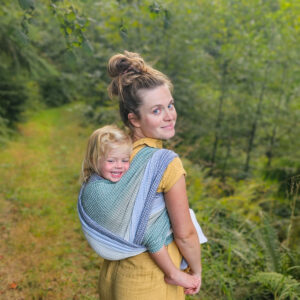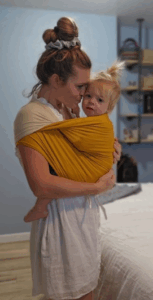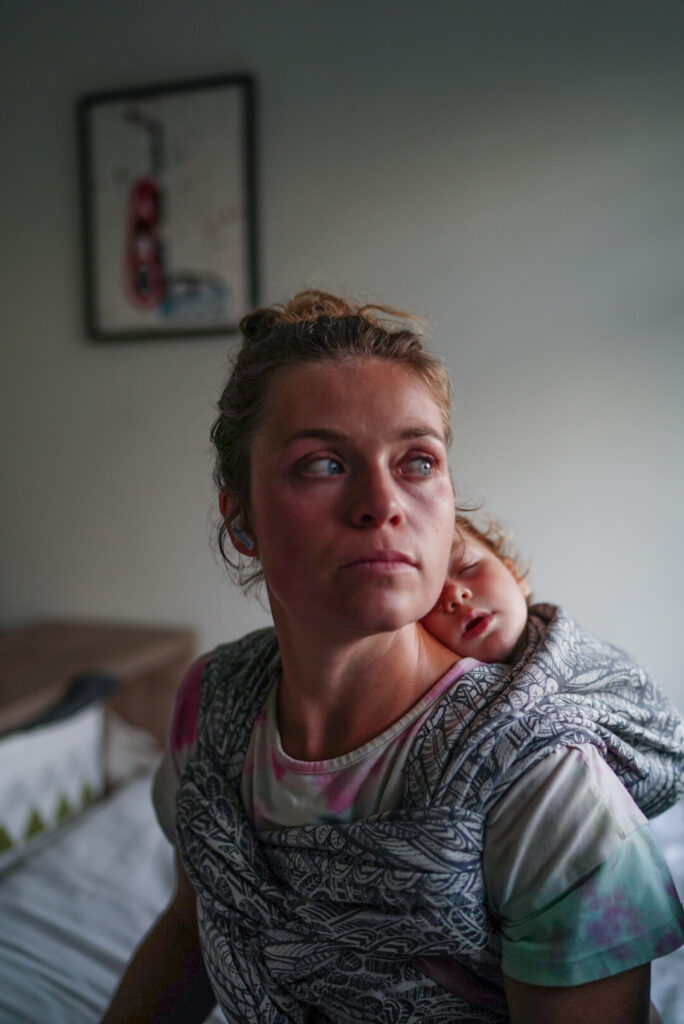Early Sensory Memories
From the time I was little, my body had very strong opinions about the world around it. Anything too restrictive or stiff felt unbearable. Jeans were out of the question until junior high, and even then I only forced myself into them because everyone else wore them and I didn’t want to stand out. I never got used to them. They bunched, pinched, and moved against my body in ways that made me want to crawl out of my skin. Yoga pants, on the other hand, became my safe place. They felt like a second skin with no restriction and no extra texture to battle.
It wasn’t just clothing. Loud environments felt like assaults on my nervous system. I loved band, but more than once I found myself overwhelmed to the point of tears, leaving rehearsals because I couldn’t process the sounds. Fireworks or big community events weren’t exciting for me. They were overwhelming. I can still remember walking home alone in the dark, my whole body buzzing, tears streaming, feeling like some kind of freak of nature for not being able to enjoy what everyone else seemed to.
And yet, just as deeply as I rejected what felt wrong, I also craved what felt good. Softness was my refuge. I was drawn again and again to certain textures. A fluffy polyester blanket could instantly calm me, wrapping me in something soothing and predictable. It wasn’t about comfort in the way people usually mean it. It was about safety, about my nervous system finally relaxing.
Touch on My Own Terms
Physical touch was always complicated. I wanted connection, but only on my own terms. My mom has told me that even as a baby, I seemed resistant to being held or touched, like my body recoiled before I even had words for why. Growing up, hugs, hand-holding, or even casual contact were things I had to force myself through. I remember friends commenting that I seemed to cringe when they leaned in for a hug. They weren’t wrong. Every cell in my body tensed with the anticipation of it.
That hasn’t fully gone away. Even now, as an adult, I crave touch in very specific contexts but struggle with it in others. What is different now is that I can articulate it. I appreciate contact when it is chosen, when I feel in control of it, when it doesn’t feel like someone else invading my space.
This complicated relationship with touch became very real when I first stepped into motherhood. Babywearing required me to move through those barriers and learn how to welcome contact that was constant, close, and inescapable. At first, it wasn’t simple. I had to learn to let my baby’s body feel like an extension of my own rather than something pressing in from the outside. Slowly, I began to experience my baby not as another person on me but as part of me. That shift, from resistance to integration, changed everything.

My First Experience With a Baby Carrier
The first time I ever put on a carrier wasn’t even with my own child. It was with a baby I cared for as a nanny. I remember the moment so clearly because it was a strange collision of feelings. On one hand, it felt awkward and even a little uncomfortable. The straps, the closeness, the unfamiliar weight pressed against me in a way that made my body instinctively question if this was safe.
And yet, layered on top of that unease was something powerful. Suddenly my hands were free, my body was capable, and I was able to move through the world while keeping a baby safe and close. For someone who had spent so much of her life struggling with unwanted touch, this was different. This was safe. This was chosen. Wearing that baby wasn’t about tolerating someone else in my space. It was about expanding my own space to include them. Their body, pressed against mine, became an extension of me. That realization was the seed of everything that came after.
Discovering Carriers Through a Sensory Lens
When I first started babywearing with my own children, I didn’t realize my sensory needs could or even should shape the carriers I chose. At the time, I just had a small handful of options and figured I had to make do with what was available. But my body quickly started teaching me otherwise.

Stretchy Wraps and the Power of Soft Fabric
I found myself drawn to stretchy wraps. There was something about their soft, forgiving fabric that felt safe against my skin. The very first wrap I tried, an original Moby, ended up feeling too stiff, almost restrictive. It moved against my body in a way that made me want to peel it off. But later, when I picked up a Boba wrap from a consignment store, it was different. That wrap felt freeing, gentle, and almost like it melted around me instead of pressing against me. It made me realize how much difference fabric could make.
Learning From the Ergo Organic
Later on, I gravitated toward the Ergo Original Organic. It was soft, pliable, and felt good to wear. When I was gifted another Ergo Original that wasn’t organic, I immediately noticed the difference. The stiffer fabric was uncomfortable, and my body refused to accept it. I never even ended up putting it on more than the initial time I tried it for a few moments. Looking back, I see so clearly how my nervous system was guiding me the entire time, even before I had language for it.
Babywearing as Both Comfort and Challenge
Babywearing, for me, has always lived in the space between comfort and challenge. In the early months of motherhood, when I was struggling with postpartum anxiety and depression, wearing my baby often felt like the safest place in the world. It was the one way I could be sure she was close, protected, and held. Having her on my body gave me a sense of safety too, as though if she was okay there, maybe I was okay too.
But there were also moments when the closeness tipped from soothing into overwhelming. If she was crying or moving too much, the sensation of her body against mine could leave me flooded with panic. I remember ripping the carrier off in desperation, pulling her out, and needing space instantly.
Many times, though, the opposite happened. The snug wrap of fabric, the rhythm of her breathing, the warmth of her body pressed against mine, those things calmed me as much as they calmed her. Wearing my babies became a shared regulation practice long before I even knew that term existed. It didn’t always begin that way. Sometimes I had to push through discomfort, even disassociate for a little while, to get through the moment knowing it would help my baby in the long run. Over time, though, I’ve learned to be present, to notice what’s happening in my body as well as in theirs, and to honor both needs. Babywearing didn’t just help me connect with my babies. It taught me to connect with myself.
When Others Touch My Baby
One thing I didn’t expect about babywearing was how it would blur the boundaries between my body and my baby’s. When I’m wearing them, they feel like an extension of me, not just emotionally but physically. Which means that when someone else touches them, my body reacts as though they’ve touched me.
It’s hard to explain, but the closest I can come is this. It feels like my skin bristles. A deep cringe starts inside my body and spreads outward, making me instantly uneasy. My shoulders rise without me realizing it, my hands twitch upward, my neck jerks slightly back. All these small, involuntary movements of defense. The tension floods through me before I even have time to think. Even when the person is only patting my baby’s back or leaning in to kiss their cheek, my body receives it as though it is happening directly to me. That realization was startling, but also clarifying. It helped me understand why certain moments felt so intolerable, why I found myself pulling away or bracing. And it has shaped the way I set boundaries with others, not just to protect my baby but to protect myself too.
What Babywearing Has Taught Me
Babywearing has taught me so much more than how to carry a child. It introduced me to parenting styles I might never have considered otherwise, and it gave me language for sensory needs, my own and my babies’. It opened my eyes to infant development, not just as something to read about in a book, but as something I could feel unfolding against my chest and in my arms.
It also gave me freedom. Freedom to move through the world with my babies close. Freedom to keep doing the things I loved. Freedom to protect both my mental and physical needs at the same time. Babywearing wasn’t always simple for me. At times it was deeply uncomfortable, even overwhelming. But it also became a place of safety, grounding, and discovery.
Most of all, it’s taught me that my differences don’t make me broken. My sensory needs aren’t flaws to erase. They are part of the way I experience life and motherhood. Babywearing didn’t erase them. It gave me a way to honor them while still embracing connection with my children.


Love this! I deeply relate to these sensory struggles, and it’s made motherhood quite the adjustment. While sometimes I feel that oneness you describe while baby wearing, other times I get so overstimulated when my little one is writhing around or crying. The constantly being needed and touched has been a lot to get used to. My little one is very sensitive, so it can be challenging balancing and integrating our sensitivities. It makes me feel less alone knowing how you relate. Thanks!
I felt so much of the struggle side of it more with my first. I feel like each baby became more a part of me and there was less frequent overstimulation- but it still happens! Especially with the movement and crying. I find myself either completely disassociating or getting really upset and frustrated when it happens, but I’m so thankful it’s become less and less- although I’m definitely finding it happen more frequently as my youngest is now getting a bit older and more active.
I’m so glad it helps to feel less alone, I never used to share any of that part because I felt so alone in it.
Your description of your sensory struggles sounds EXACTLY what my ten year old daughter is dealing with. I’m going to read her this article tomorrow to show her she’s not alone :).
I hope it’s helpful to her to know she’s not alone- I know that was one of the hardest parts for me.